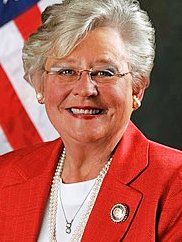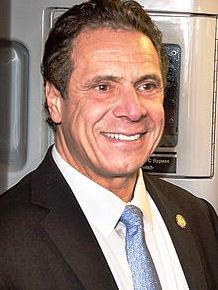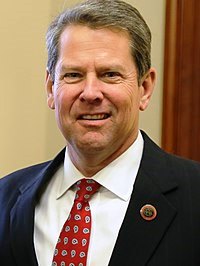Posts Tagged ‘COVID-19’
» posted on Friday, July 1st, 2022 by Linda Lou Burton
Deja Re-View
No Mask Needed This Way, July 1, 2020
Originally published July 1, 2020 by Linda Lou Burton posting from Little Rock, Arkansas – I had a friend who had 366 notebooks lining the shelves of his office, labeled with each day of the year, yes, even including Leap. Every day he added a new page in the proper notebook . He could tell you exactly what he was doing, and thinking, and feeling, on any day as far back as twenty years.
On February 29 of this Leap Year, I got news of the first case of the COVID-19 virus in the United States. I was standing in the arena at the fairgrounds here in Little Rock, attending the state Flower & Garden Show with a friend. She was checking her phone for messages, and the news popped up. “Where?” I asked. I’d spent the last month booking reservations for my Round The World trip in July that would take me to the last two continents on my list of seven – Australia and Asia. I had scrupulously avoided China in the plan, due to rumblings of a highly contagious disease and contaminated cruise ships there.
When she told me the case was in Seattle, I was not only startled, but genuinely alarmed, as it was precisely in the area where two of my sons live, with their families. Six grandchildren there! And, Seattle was to be the first stop on the Journey Round The World. My flight was booked for July 7.
“Oh, it will all be done by May,” was the line on everybody’s lips. “Don’t worry.”
I have been tracking the numbers since March 1. As of today 2,624,873 cases have been reported in the United States and its territories by the Centers for Disease Control; with 127,299 deaths from the disease. The only “US soil” that has remained virus-free is American Samoa, which was to be a major stop on my RTW.
There were several kinds of things the RTW would tick off my list of “things to do before I die” (aka Bucket List). I could claim all seven continents as mine; and all five oceans. I would visit the southernmost and northernmost capital cities in the world – Wellington, New Zealand and Reykjavik, Iceland. I would cruise the longest rivers on the continents of Australia and Africa – the Murray and the Nile. I would visit two wonders of the world – Ayers Rock or Uluru, the giant red monolith in the heart of Australia; and the Sphinx and the Pyramids of Giza in Egypt. I would visit three far-flung US National Parks – Haleakala and Hawaii Volcanoes in Hawaii; American Samoa in – well, American Samoa. And best of all, I would add nine world capital cities to my Capital City list! With the added bonus of having my two youngest grandchildren join me in Reykjavik as a “high school graduation gift,” with my RTW ending in Washington, DC with grandkids, in an election year!
This trip would be a crown in my crowns. The grandkids, Kayla and Sam, had been a part of the Journey Across America in 2012; Kayla to Honolulu with me; Sam to Juneau. Now those 4th graders are done with high school! And what a (excuse the language please) SUCKY senior year they were served; schools were closed in March so no senior prom, no bonding with friends, just a Virtual Do and, that’s it. Also, sadly, no trip to Reykjavik, and Washington, DC.
I am now 81 years old, and although the airlines have offered “rebooking” opportunities in years to come, I don’t plan to travel worldwide until the word “pandemic” is erased from our daily conversation and the (currently non-existent) vaccine is keeping everyone, all over the world, SAFE from COVID-19.
So, here’s the deal. I’ll do my traveling VIRTUALLY, and tell you all about it. Plus, I’ll review and update the 51 wonderful capitals I visited on the Journey Across America. I’ve always believed the best thing about travel is the memories; they never RUST or wear out. They nurture you when you are “too old to rock the rocking chair.” (And I am getting close to that.)
On July 1, 2012, I had just returned from Honolulu with Kayla, and was settling in for a two-week stint in Olympia, the capital city of Washington. It was a cool, gray day, as my cats Alex and Jack settled in with me in a peaceful spot.
On July 1, 2013, I was in Des Moines, the capital city of Iowa, where one expected the corn to be “knee high by the 4th of July.” I learned a lot about pigs there too, and genuine Midwestern friendliness.
Today, July 1, 2020, I live in Little Rock, the capital city of Arkansas, with my Katy cat, where Social Distancing is now the required norm, and face masks the recommended attire.
Still in love with capital cities. Still enjoying the world we live in.
Go with me? You won’t even need a face mask!
Knee High By The 4th of July, July 1, 2013
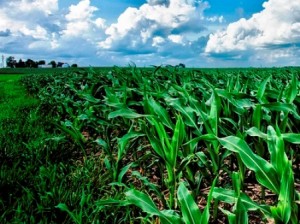 Linda Burton posting from Des Moines, Iowa – “Oh What A Beautiful Morning!” Remember that Rodgers & Hammerstein tune from Oklahoma? Driving through the Iowa countryside a few days ago, with early summer cornfields rolling across the hills to my right and to my left, I thought of a line from that song “….the corn is as high as an elephants eye….” Then I laughed, because the corn I saw was just beginning to get a grip on growing; it’s pretty darned early in the season here. “That corn is only knee high,” I thought. Later I learned that’s the catch-phrase of corn farmers: “We look for the corn to be knee high by the 4th of July,” I was told. That’s the
Linda Burton posting from Des Moines, Iowa – “Oh What A Beautiful Morning!” Remember that Rodgers & Hammerstein tune from Oklahoma? Driving through the Iowa countryside a few days ago, with early summer cornfields rolling across the hills to my right and to my left, I thought of a line from that song “….the corn is as high as an elephants eye….” Then I laughed, because the corn I saw was just beginning to get a grip on growing; it’s pretty darned early in the season here. “That corn is only knee high,” I thought. Later I learned that’s the catch-phrase of corn farmers: “We look for the corn to be knee high by the 4th of July,” I was told. That’s the 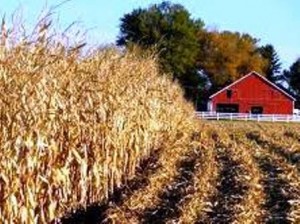 assurance that everything is on track; “elephant’s eye” corn isn’t expected until late September; most harvesting happens in October and sometimes into November. Then there’s a lot of harvesting going on; in 2012 Iowa corn farmers grew almost 1.88 billion bushels of corn, on 13.7 million acres of land; 2013 projections indicate 2.45 billion bushels on 13.97 million acres. Iowa has produced the largest corn crop of any state for more than two decades; in an average year, Iowa produces more corn than most countries! And it’s been the dominant
assurance that everything is on track; “elephant’s eye” corn isn’t expected until late September; most harvesting happens in October and sometimes into November. Then there’s a lot of harvesting going on; in 2012 Iowa corn farmers grew almost 1.88 billion bushels of corn, on 13.7 million acres of land; 2013 projections indicate 2.45 billion bushels on 13.97 million acres. Iowa has produced the largest corn crop of any state for more than two decades; in an average year, Iowa produces more corn than most countries! And it’s been the dominant  crop in Iowa for more than 150 years. The reasons are simple – a growing season that is long enough and warm enough, ample rain, and deep, rich soil. Iowa also produces livestock whose waste includes nutrients that are key to fertilizing the fields for better corn production. According to Iowa Agriculture farm statistics, in 2012 there were 195,000 sheep and lambs on hand, 3.9 million cattle and calves, and 20 million hogs. And, by the way, Iowa is the number one pork producing state in the country too.
crop in Iowa for more than 150 years. The reasons are simple – a growing season that is long enough and warm enough, ample rain, and deep, rich soil. Iowa also produces livestock whose waste includes nutrients that are key to fertilizing the fields for better corn production. According to Iowa Agriculture farm statistics, in 2012 there were 195,000 sheep and lambs on hand, 3.9 million cattle and calves, and 20 million hogs. And, by the way, Iowa is the number one pork producing state in the country too.
I went to the Iowa Agriculture website for some basic farm facts; I wanted to know how many farms there are in Iowa, overall. The answer (as of 2011) is 92,300 farms, covering 30.7 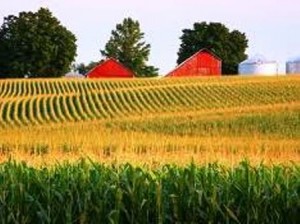 million acres of the state. The size of an average farm is 333 acres, valued at about $6,708 per acre. That long growing season I mentioned has temperatures ranging from an average of 13.2F in January to 75.3F in July, with an average annual rainfall of 45.10 inches. Soybeans, milk, and eggs are other biggies in the state; 466 million bushels of soybeans grown on 9.23 million acres in 2011; 4.33 billion pounds of milk produced; 14.5 billion eggs. Equate that to how many glasses of milk you drink in a week, or how many sunny-side-up breakfasts you enjoy. As to the bacon that accompanies those breakfast eggs – I pulled some numbers from the National Pork Board and the US Census of Agriculture. Iowa has about 8,300 hog operations; more than 39,000 jobs are directly related to raising and caring for hogs in Iowa; the industry generates nearly $950 million in household income for pork producers.
million acres of the state. The size of an average farm is 333 acres, valued at about $6,708 per acre. That long growing season I mentioned has temperatures ranging from an average of 13.2F in January to 75.3F in July, with an average annual rainfall of 45.10 inches. Soybeans, milk, and eggs are other biggies in the state; 466 million bushels of soybeans grown on 9.23 million acres in 2011; 4.33 billion pounds of milk produced; 14.5 billion eggs. Equate that to how many glasses of milk you drink in a week, or how many sunny-side-up breakfasts you enjoy. As to the bacon that accompanies those breakfast eggs – I pulled some numbers from the National Pork Board and the US Census of Agriculture. Iowa has about 8,300 hog operations; more than 39,000 jobs are directly related to raising and caring for hogs in Iowa; the industry generates nearly $950 million in household income for pork producers.
Enough with the numbers; I wanted to know what kind of hogs are raised, and what is different about each breed. But first a little Pig Latin Lesson: “boars” are males of breeding  age; “sows” are breeding females; and “piglets” need no explanation; they are the unweaned little ones.
age; “sows” are breeding females; and “piglets” need no explanation; they are the unweaned little ones.
From the Des Moines National Pork Board website, which also has delicious recipes for the use of pork, I learned that most hogs bred for consumption are the offspring of a combination of breeds – usually dark-breed boars bred to white-breed sows. Dark breed boars enhance meat quality; white-breed sows produce many piglets, plus their maternal instincts allow more piglets to survive. A producer will choose a particular breed, or combination of genetic lines, based on what they are looking for with regard to meat quality, farming method, and the hog market. Here are eight of the most widely popular.
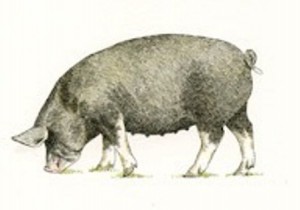 Berkshire. A black pig that originated in Britain in the mid-1500s, prized for juiciness, flavor, and tenderness, yielding a pink-hued, heavily marbled meat suitable for long cooking times.
Berkshire. A black pig that originated in Britain in the mid-1500s, prized for juiciness, flavor, and tenderness, yielding a pink-hued, heavily marbled meat suitable for long cooking times.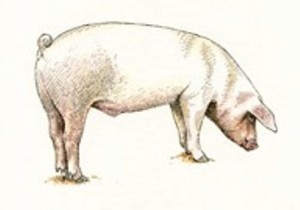 Chester White. Used in commercial crossbreeding; originated in Pennsylvania in the early 1800s when white pigs common to the northeast US were bred with a white boar imported from Bedfordshire, England.
Chester White. Used in commercial crossbreeding; originated in Pennsylvania in the early 1800s when white pigs common to the northeast US were bred with a white boar imported from Bedfordshire, England. Duroc. Known for quick growth; red or black coloring; the second most recorded breed in the US; a main sire choice of American farmers. Sweet meat, amazing shoulders and spareribs.
Duroc. Known for quick growth; red or black coloring; the second most recorded breed in the US; a main sire choice of American farmers. Sweet meat, amazing shoulders and spareribs. Hampshire. Fourth most recorded breed in America and oldest American breed in existence; stock imported from Wessex, England in 1832. Black with a white belt across the shoulders, a lean-meat breed.
Hampshire. Fourth most recorded breed in America and oldest American breed in existence; stock imported from Wessex, England in 1832. Black with a white belt across the shoulders, a lean-meat breed.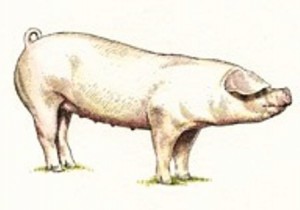 Landrace. Fifth most recorded breed in the US; known for large litters of piglets. A white pig, descended from the Danish Landrace; produces a large and flavorful ham and loin.
Landrace. Fifth most recorded breed in the US; known for large litters of piglets. A white pig, descended from the Danish Landrace; produces a large and flavorful ham and loin.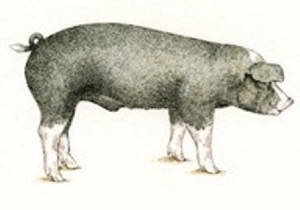 Poland China. Black with white face and feet, derives from many breeds, including the Berkshire and the Hampshire. Known for large size; one of the most common breeds in the US.
Poland China. Black with white face and feet, derives from many breeds, including the Berkshire and the Hampshire. Known for large size; one of the most common breeds in the US. Spotted Pig. Black and white spots, no red or brown; popular in the US because of high meat quality and ability to gain weight quickly.
Spotted Pig. Black and white spots, no red or brown; popular in the US because of high meat quality and ability to gain weight quickly.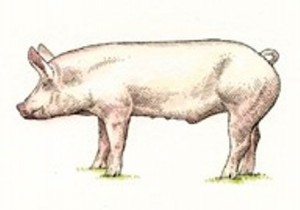 Yorkshire. #1 recorded breed in the US; white, very durable and muscular, high proportion of lean meat. Developed in the county of York, England, and brought to the US around 1830.
Yorkshire. #1 recorded breed in the US; white, very durable and muscular, high proportion of lean meat. Developed in the county of York, England, and brought to the US around 1830.
Now that you’re up on pigs, let’s get back to corn. Because, you see, most Iowa corn goes into animal feed. One bushel of corn converts to about 13 pounds of retail pork. Iowa’s corn is 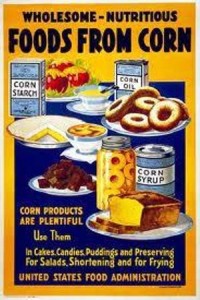 also processed into starches, oil, sweeteners, and ethanol. Most of the corn you see growing in fields across Iowa is field corn, not the sweet corn-on-the-cob you think about for summer cookouts, dripping with butter. The sweet corn that is grown in Iowa is usually sold at farmers’ markets and roadside stands, not shipped out of state, so if you live in Arizona or Vermont, you’ll likely never see Iowa corn in your supermarket. But it will be in products you use – the Corn Refiners Association has conducted surveys tallying all supermarket products that contain corn ingredients and come up with the staggering number of at least 4,000. Read your labels! Corn is nearly everywhere – even used in paper products.
also processed into starches, oil, sweeteners, and ethanol. Most of the corn you see growing in fields across Iowa is field corn, not the sweet corn-on-the-cob you think about for summer cookouts, dripping with butter. The sweet corn that is grown in Iowa is usually sold at farmers’ markets and roadside stands, not shipped out of state, so if you live in Arizona or Vermont, you’ll likely never see Iowa corn in your supermarket. But it will be in products you use – the Corn Refiners Association has conducted surveys tallying all supermarket products that contain corn ingredients and come up with the staggering number of at least 4,000. Read your labels! Corn is nearly everywhere – even used in paper products.
And corn grows nearly everywhere; you’ll find it on every continent except Antarctica. It is descended from a plant called teosinte, which still grows in Mexico; the first corn plants seem to have appeared in Mexico. Millenniums of breeding, first by Native Americans, then by 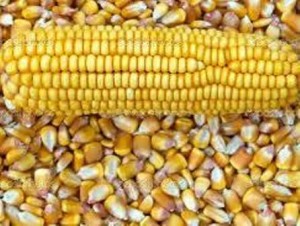 early pilgrims and modern scientists, have resulted in larger, fuller ears, and made corn one of the world’s three leading grain crops (rice and wheat are the others). Much of Iowa’s field corn is bred to develop just one large ear rather than several incomplete ears; the number of kernels per ear vary from 500 to 1,200, but a typical ear has about 800 kernels. A bushel of shelled corn (after husks and cobs are removed) weighs about 56 pounds and last year Iowa corn growers harvested an average of 172 bushels per acre of land (the national average was 147). To further visualize, an acre is about the size of a standard football field.
early pilgrims and modern scientists, have resulted in larger, fuller ears, and made corn one of the world’s three leading grain crops (rice and wheat are the others). Much of Iowa’s field corn is bred to develop just one large ear rather than several incomplete ears; the number of kernels per ear vary from 500 to 1,200, but a typical ear has about 800 kernels. A bushel of shelled corn (after husks and cobs are removed) weighs about 56 pounds and last year Iowa corn growers harvested an average of 172 bushels per acre of land (the national average was 147). To further visualize, an acre is about the size of a standard football field.
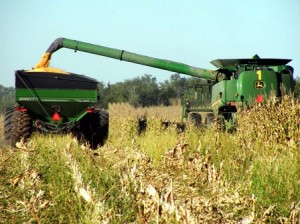 About those husks and cobs – when corn is harvested the combine strips the husks off each ear and removes the kernels; the kernels are stored in a holding tank until they can be unloaded into a truck. But the husks and cobs are spread back into the field as the combine moves along; it’s just like mulch in your home garden. Good soil fertility is there for the next crop; corn plants that will grow up to 12 feet tall, just about as high, I’m thinking, as an elephant’s eye.
About those husks and cobs – when corn is harvested the combine strips the husks off each ear and removes the kernels; the kernels are stored in a holding tank until they can be unloaded into a truck. But the husks and cobs are spread back into the field as the combine moves along; it’s just like mulch in your home garden. Good soil fertility is there for the next crop; corn plants that will grow up to 12 feet tall, just about as high, I’m thinking, as an elephant’s eye.
Sunday Morning Coming Down, July 1, 2012
 Linda Burton posting from Olympia, Washington – The joke is “summer doesn’t arrive in the Pacific Northwest until after the 4th of July” but it’s no joke. In 1987 I dried out in front of a blazing fire after giving up on the soggy Seattle fireworks display and coming home sopping wet and shivering. It looks as though this year will follow that pattern; it was raining when I woke up; a Sunday morning gray. A cat snuggled tight against either side of me; I guess I’m forgiven for taking off for Hawaii and leaving them behind. I opened up the Fancy Feast and then slept two hours more. Under the blanket and the pile of cats it was cozy and warm, but checkout time loomed close; time to load the car, drive to Olympia, unload everything, settle in for the next two-week stint. I was misty-soaked and feeling blue in all the gray, my body temp still set on Hawaiian warm. Just drive, I told myself.
Linda Burton posting from Olympia, Washington – The joke is “summer doesn’t arrive in the Pacific Northwest until after the 4th of July” but it’s no joke. In 1987 I dried out in front of a blazing fire after giving up on the soggy Seattle fireworks display and coming home sopping wet and shivering. It looks as though this year will follow that pattern; it was raining when I woke up; a Sunday morning gray. A cat snuggled tight against either side of me; I guess I’m forgiven for taking off for Hawaii and leaving them behind. I opened up the Fancy Feast and then slept two hours more. Under the blanket and the pile of cats it was cozy and warm, but checkout time loomed close; time to load the car, drive to Olympia, unload everything, settle in for the next two-week stint. I was misty-soaked and feeling blue in all the gray, my body temp still set on Hawaiian warm. Just drive, I told myself.
It’s a mess, I-5 I mean; and the speed limit is 60 all the way; what’s that about? The Girl Scout motto learned so many years ago forgot, I put no water for the kitties in the back; didn’t fill the litter box; it was a short drive to Olympia.  And so you see, I was not prepared for the rooms reserved weeks ago to be refused to me. A chain I often used, this one did not accept cats; my “Pet Friendly” filter somehow slipped. (Big expose some day, about the inconsistencies of chains, and the unkindnesses to pets!) They refused me gently though, and called to find a room for me. A downtown highrise, not my favorite choice, but decision-making time was running short (no water, and no litter box).
And so you see, I was not prepared for the rooms reserved weeks ago to be refused to me. A chain I often used, this one did not accept cats; my “Pet Friendly” filter somehow slipped. (Big expose some day, about the inconsistencies of chains, and the unkindnesses to pets!) They refused me gently though, and called to find a room for me. A downtown highrise, not my favorite choice, but decision-making time was running short (no water, and no litter box).
My reaction was muted by the gray; okay, I’ll take the room. It wasn’t ready yet, please sort it out, I begged. Housekeeper beeped another floor, got somebody on it, quick. “Start your unload,” she soothed, “and bring those kitties in.” She described her long-haired cat, her love of 15 years, “I want to meet your Jack,” she smiled, “and Alex too.” I warmed from blue to pink. Four loads with the rattley cart; four floors on the elevator; and then, we’re home and all is well. Let’s watch the evening news, and catch up with the rest of the world.
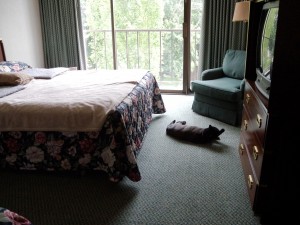 It’s pleasant here. No doubt that things would turn out fine; I’ve got the Bubble over me. Dig through the suitcase for warmer clothes, zip the black sweater clear up to my neck, pull on some socks. It was 109 in Nashville today, the Brian Williams Sunday-substitute is telling on the news, and power’s out all in the stormy east. But I am safe, here at the end of Puget Sound, looking forward to the peace, and quiet, and gentle soothing gray; an easy place to be.
It’s pleasant here. No doubt that things would turn out fine; I’ve got the Bubble over me. Dig through the suitcase for warmer clothes, zip the black sweater clear up to my neck, pull on some socks. It was 109 in Nashville today, the Brian Williams Sunday-substitute is telling on the news, and power’s out all in the stormy east. But I am safe, here at the end of Puget Sound, looking forward to the peace, and quiet, and gentle soothing gray; an easy place to be.
» posted on Wednesday, September 2nd, 2020 by Linda Lou Burton
Hair Today
 September 2, 2020, Linda Lou Burton posting from Little Rock, Arkansas – It makes sense that Donald would comment on Nancy getting her hair blow dried; something a big hair guy would be sure to notice. Hard to tell if the hullabaloo is about Nancy walking down a hallway with wet hair and no mask, or the idea that blow driers in and of themselves are deadly. Geez, it’s hard to look pretty, with this virus thingy making a haircut so dangerous. I decided to check it out. What evil lurks in the hair salon these days? Beauty Parlor Gossip was the worst thing about such an environment in years past; Eudora Welty claimed to get some of her best story ideas from an afternoon under the drier. One of her short stories, The Petrified Man, is actually set in a
September 2, 2020, Linda Lou Burton posting from Little Rock, Arkansas – It makes sense that Donald would comment on Nancy getting her hair blow dried; something a big hair guy would be sure to notice. Hard to tell if the hullabaloo is about Nancy walking down a hallway with wet hair and no mask, or the idea that blow driers in and of themselves are deadly. Geez, it’s hard to look pretty, with this virus thingy making a haircut so dangerous. I decided to check it out. What evil lurks in the hair salon these days? Beauty Parlor Gossip was the worst thing about such an environment in years past; Eudora Welty claimed to get some of her best story ideas from an afternoon under the drier. One of her short stories, The Petrified Man, is actually set in a 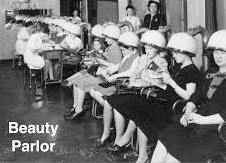 beauty parlor. Lots of gossip in that one. Yes, back before Twitter, we relied on our beauty parlors to spread tales.
beauty parlor. Lots of gossip in that one. Yes, back before Twitter, we relied on our beauty parlors to spread tales.
But back to our modern hair salons, and the dangers they may, or may not, present for us. Prevention magazine recently interviewed infectious disease specialist Michael Ben-Aderet, MD, about salon safety tips and recommendations in the age of COVID-19. The article appears at a time when many states are easing restrictions and businesses like hair salons are reopening.
“The number one-way coronavirus spreads is through respiratory droplets from someone who is sick,” said Ben-Aderet, explaining the virus spreads the same way in salons as it does anywhere – making it increasingly more important that sick people do not enter salons. “One way to do this is to screen clients before appointments to make sure those who are sick reschedule if they have fever, cough, or shortness of breath.” But many people want to know what happens if someone sick does enter a salon. Can products and tools like a blow dryer spread COVID-19?
“A blow dryer does have the potential to spread contaminated air around a room,” said Ben-Aderet. “But again, there needs to be an infected person around. Unless someone coughs into a hair dryer and that spreads the droplets, it’s very unlikely.” As for the blow dryer itself, Ben-Aderet says it’s “unlikely for a hair dryer to be contaminated with coronavirus.” He does explain, however, that while viruses can’t grow on surfaces, they can persist on certain surfaces for a particular amount of time, making it imperative that each salon is cleaned and disinfected after each client. “Touching a surface that is contaminated with secretions or mucus membranes from a sick individual and then touching your face can make you sick,” said Ben-Aderet. “It’s important to remember that viruses need to grow in a person.”
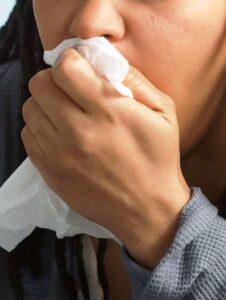 So there you have it. A sick PERSON is the dangerous thing. And if not yet obviously sick, A VIRUS CARRIER. If nobody is hauling the virus around on their body, and coughing and touching things with their virus-contaminated droplets, or hands they just wiped against their nose, there is no virus to get anybody else sick. And the notion of “sick people” spreading things to other people is true for ordinary colds, the flu, and lots of other stuff that people transmit from one to another. It’s rude to take your sick self out and put your germs off on somebody else. Don’t do it!
So there you have it. A sick PERSON is the dangerous thing. And if not yet obviously sick, A VIRUS CARRIER. If nobody is hauling the virus around on their body, and coughing and touching things with their virus-contaminated droplets, or hands they just wiped against their nose, there is no virus to get anybody else sick. And the notion of “sick people” spreading things to other people is true for ordinary colds, the flu, and lots of other stuff that people transmit from one to another. It’s rude to take your sick self out and put your germs off on somebody else. Don’t do it!
We’re advised to wear masks when we do go out now, so if we have that Virus Thingy, we don’t spread it. This is a dangerous proviso – having a mask dangling around your neck and not properly positioned, or made of the wrong material, or not kept clean, is as bad as not having one at all. Also, RELYING on a mask as your ultimate protection is foolhardy. Look at these videos showing how far DROPLETS can travel THROUGH a mask!
https://www.youtube.com/watch?v=evATiHUejxg&feature=youtu.be
Tomorrow: Masks Better Than Even The Lone Ranger Wore
» posted on Tuesday, September 1st, 2020 by Linda Lou Burton
That Virus Thingy
September 1, 2020, Linda Lou Burton posting from Little Rock, Arkansas – Six months have passed since we really started counting “that virus thingy.” I check the US stats on the Centers for Disease Control website every week; so far no US state or territory has had a week go by with NO new cases. Except for American Samoa, bless their peaceful, well-isolated hearts. Today I took a worldwide look – the World Health Organization has an excellent site and really good advice. It’s vitally important to track what is going on in our own neighborhood, but I believe it is equally important to track what is happening beyond our borders. Compare – how are they managing? How are we, in the US?
for Disease Control website every week; so far no US state or territory has had a week go by with NO new cases. Except for American Samoa, bless their peaceful, well-isolated hearts. Today I took a worldwide look – the World Health Organization has an excellent site and really good advice. It’s vitally important to track what is going on in our own neighborhood, but I believe it is equally important to track what is happening beyond our borders. Compare – how are they managing? How are we, in the US?
 As of the beginning of September, 2020, the World Health Organization shows 25,541,380 cases of COVID-19 reported worldwide; 852,000 deaths. If we want to compare that death count with the population of cities of equal size – we could say that EVERYBODY in Indianapolis, Indiana is dead now. Or, Seattle, Washington. Dead. No living, breathing persons left in those cities. When you look at it THAT way, it seems like a lot of deaths, doesn’t it? Other cities in the US that have populations in the 800,000 range are Charlotte, North Carolina; San Francisco, California, Columbus, Ohio; Forth Worth, Texas. Imagine them gone! Imagine a dystopian horror tale, such as Peter Heller’s The Dog Stars
As of the beginning of September, 2020, the World Health Organization shows 25,541,380 cases of COVID-19 reported worldwide; 852,000 deaths. If we want to compare that death count with the population of cities of equal size – we could say that EVERYBODY in Indianapolis, Indiana is dead now. Or, Seattle, Washington. Dead. No living, breathing persons left in those cities. When you look at it THAT way, it seems like a lot of deaths, doesn’t it? Other cities in the US that have populations in the 800,000 range are Charlotte, North Carolina; San Francisco, California, Columbus, Ohio; Forth Worth, Texas. Imagine them gone! Imagine a dystopian horror tale, such as Peter Heller’s The Dog Stars 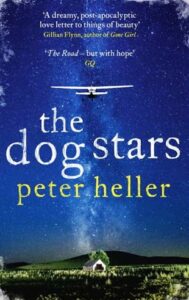 (2012); a world where the unexpected happened – a flu pandemic struck – and life on the planet had to adjust to “what is.” While I’m a believer in Positive Thinking, I’m also a believer in being well-informed. And approaching life in ways that are reasonable, and not based on impatience to “get back to normal, now!” Like, opening schools. Sure, kids are getting a sucky education right now. Sure, parents are sick and tired of having to manage and monitor their children’s schooling from home. Sure – well the issue is ablaze in arguments and accusations and vastly different proposals. Politics involved. What is the best solution? Start with facts.
(2012); a world where the unexpected happened – a flu pandemic struck – and life on the planet had to adjust to “what is.” While I’m a believer in Positive Thinking, I’m also a believer in being well-informed. And approaching life in ways that are reasonable, and not based on impatience to “get back to normal, now!” Like, opening schools. Sure, kids are getting a sucky education right now. Sure, parents are sick and tired of having to manage and monitor their children’s schooling from home. Sure – well the issue is ablaze in arguments and accusations and vastly different proposals. Politics involved. What is the best solution? Start with facts.
Here are the numbers broken down by sections of the world, and then the US.
World Health Organization Statistics – Number of Cases Reported Worldwide as of September 1, 2020
- Americas – 13,469,747
- SE Asia – 4,318,281
- Europe – 4,225,328
- Eastern Mediterranean – 1,939,204
- Africa – 1,056,120
- Western Pacific – 501,959
- TOTAL WORLDWIDE – 25,541,380
Of the Americas, that’s both North and South, let’s look at what is happening just in the United States. We’ve got the most cases of any American country — 6,004,443 COVID-19 cases reported to date; 183,050 deaths from the virus. That “death” total kills off everybody in Little Rock, just about! The US numbers are big, and continue to get bigger. Over the next month, I’ll be looking at what other countries in the world are doing to combat a pandemic that is “sure ‘nough” real, and how they are keeping their citizens safe.
Meanwhile, wash your hands, keep your chin up (with MASK intact!), and if you happen to live in any of the states below, get in touch with your governor because your state is leading the pack this week, an honor you don’t want.
US States With Highest Percent of Population Diagnosed With COVID-19 as of September 1
- Louisiana – 3.2%, Governor John Bel Edwards, Democrat
- Florida – 2.87%, Governor Ronald Dion DeSantis, Republican
- Mississippi – 2.81%, Governor Jonathon Tate Reeves, Republican
- Arizona – 2.77%, Governor Douglas Anthony Ducey, Republican
- Alabama – 2.57%, Governor Kay Ellen Ivey, Republican
US States With Greatest Numbers of COVID-19 Cases Diagnosed as of September 1
- California – 704,485, Governor Gavin Christopher Newsom, Democrat
- Florida – 616,629, Governor Ronald Dion DeSantis, Republican
- Texas – 612,969, Governor Gregory Wayne Abbott, Republican
- New York – 435,783, Governor Andrew Mark Cuomo, Democrat
- Georgia – 270,471, Governor Brian Porter Kemp, Republican
US States With Most New Cases Diagnosed in One Week as of September 1
- California – 40,416, Governor Gavin Christopher Newsom, Democrat
- Texas – 35,432, Governor Gregory Wayne Abbott, Republican
- Florida – 22,342, Governor Ronald Dion DeSantis, Republican
- Georgia – 16,522, Governor Brian Porter Kemp, Republican
- Illinois – 15,130, Governor Jay Robert “J. B.” Pritzker, Democrat
» posted on Thursday, August 20th, 2020 by Linda Lou Burton
Voting, and the Virus
Linda Lou Burton posting from Little Rock, Arkansas – As of August 20, the World Health Organization reports 22,536,278 cases of COVID-19 in the world. Of that, 5,511,793 cases are in the United States, a number which amounts to one quarter, that is 25% of the worldwide total. In case you’re wondering, the population of the United States is 5% of the world population. Just saying.
I find it difficult to keep up with the current hoopla about “who is doing what when” with regard to decisions about managing a pandemic on local ground; and even more hoopla about “how to have a secure vote” with regard to the upcoming presidential election. So the recent announcement about New Zealand’s decision to postpone a national election due to an upsurge in COVID-19 cases really caught my eye.
Action in New Zealand
 On Monday, August 17 Prime Minister Jacinda Ardern of New Zealand announced that the September national election would be delayed by four weeks as new virus cases spread across Auckland, making it difficult to campaign. Prime Minister Ardern, who has the sole authority to determine when people cast ballots, said she had consulted with all the major parties before delaying the vote, originally scheduled for September 19, to October 17. Ms Ardern called the decision a compromise that “provides sufficient time for parties to plan around the range of circumstances we could be campaigning under, for the electoral commission to prepare, and for voters to feel assured of a safe, accessible and critical election.”
On Monday, August 17 Prime Minister Jacinda Ardern of New Zealand announced that the September national election would be delayed by four weeks as new virus cases spread across Auckland, making it difficult to campaign. Prime Minister Ardern, who has the sole authority to determine when people cast ballots, said she had consulted with all the major parties before delaying the vote, originally scheduled for September 19, to October 17. Ms Ardern called the decision a compromise that “provides sufficient time for parties to plan around the range of circumstances we could be campaigning under, for the electoral commission to prepare, and for voters to feel assured of a safe, accessible and critical election.”
The shift keeps Election Day within the time frame allowed under the law — the latest possible date is November 21 — but it also highlights the national concern as a cluster of at least 58 new cases frustrates investigators, clears the streets of Auckland and suspends scheduled campaign events. Pressure on Ms Ardern and her Labour Party to change the date had been building over several days. A poll taken over the weekend showed that 60 percent of New Zealanders favored a delay. The leaders of other major parties also argued that the Level 3 lockdown in Auckland, the country’s largest city, prevented campaigning and would have made a free and fair election impossible on the original date.
I noted earlier, when on my NDI RTW visit to New Zealand, that their voting process is quite different from the US, where campaigning begins early and the media races to outdo itself by predicting, and announcing, results “before midnight.” I still recall my frustration in Seattle one year when I headed for the polls after work, only to hear “the winner declared” on the car radio. With our current Cell Phone Mentality, it’s a second-by-second race to get ahead of the game. I call it blather. Just saying.
From the New Zealand Electoral Commission webpage, I see today’s schedule for their 2020 General Election.
- Monday 17 August: Prime Minister announces new dates for the 2020 General Election
- Tuesday 18 August: Regulated period for election advertising expenses begins
- Sunday 6 September: Parliament dissolves
- Sunday 13 September: Writ Day – the Governor General formally directs us to hold the Election
- Thursday 17 September noon: Deadline for party secretaries to get their bulk nomination schedules and the party lists to us
- Friday 18 September noon: Deadline for electorate candidates to get their individual nomination forms to us
- Wednesday 30 September: Overseas voting starts
- Saturday 3 October: Advance voting starts
- Friday 16 October: Advance voting ends
- Friday 16 October midnight: The regulated period ends. All election and referendum advertising must end. Signs must be taken down by midnight.
- Saturday 17 October: Election day. Voters can vote from 9am to 7pm
- We’ll start releasing preliminary election results from 7pm on electionresults.govt.nz
- We won’t count referendum votes on election night
- Friday 30 October: We release the preliminary results for the referendums
- Friday 6 November: We declare the official results for the general election and referendums
- Thursday 12 November: Last day for the return of the writ
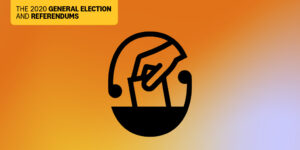 Easy peasy. Sit back and have a cup of tea. So, what will Ms Arden and the New Zealand government DO during this “delayed election” time? They will focus primarily on the virus. Health officials in New Zealand are scrambling to test thousands of workers at airports and other points of entry, along with quarantine facilities and a frozen food warehouse, to try to determine how the virus re-emerged last week.
Easy peasy. Sit back and have a cup of tea. So, what will Ms Arden and the New Zealand government DO during this “delayed election” time? They will focus primarily on the virus. Health officials in New Zealand are scrambling to test thousands of workers at airports and other points of entry, along with quarantine facilities and a frozen food warehouse, to try to determine how the virus re-emerged last week.
New Zealand’s election is far from the first to be postponed because of the pandemic. The International Foundation for Electoral Systems reports as of 08/20/2020 that 64 countries and eight territories have postponed a total of 109 election events due to COVID-19, ranging from local municipal elections to parliamentary and national events. The idea of delaying the US general election was floated by President Donald Trump, but it was shut down by members of Congress and his own party.
Everything you need to know about voting in New Zealand https://vote.nz/
Everything you need to know about voting in United States https://www.usa.gov/election





